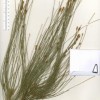 Australian pine was originally planted in Florida in the late 1800’s as a windbreak and for shade. But soon thereafter it was spreading without help from humans. Today it is considered a category I invasive species in Florida, and the Division of Plant Industry strictly prohibits possessing, transporting, and cultivating this species. For those who find this tree in close proximity to their home, it’s a good idea to replace it since Australian pine is known to have a very low resistance to wind. Australian pine is commonly found growing on coastal shorelines since it thrives in salty, sandy environments. This 2-page fact sheet was written by Michael G. Andreu, Melissa H. Friedman, and Robert J. Northrop, and published by the UF Department of School of Forest Resources and Conservation, July 2012.
Australian pine was originally planted in Florida in the late 1800’s as a windbreak and for shade. But soon thereafter it was spreading without help from humans. Today it is considered a category I invasive species in Florida, and the Division of Plant Industry strictly prohibits possessing, transporting, and cultivating this species. For those who find this tree in close proximity to their home, it’s a good idea to replace it since Australian pine is known to have a very low resistance to wind. Australian pine is commonly found growing on coastal shorelines since it thrives in salty, sandy environments. This 2-page fact sheet was written by Michael G. Andreu, Melissa H. Friedman, and Robert J. Northrop, and published by the UF Department of School of Forest Resources and Conservation, July 2012.
http://edis.ifas.ufl.edu/fr366
Tag: Australian-Pine
HS1139/HS392 Casuarina cunninghamiana Miq. (River sheoak) in Florida and its Potential as a Windbreak Plant for Citrus Groves
HS-1139, a 12-page illustrated fact sheet by William S. Castle, compiles pertinent information and provide an historical perspective for environmentalists, biologists, scientists and other interested parties regarding the Casuarina species in Florida which are presently classified as invasive and illegal to possess or propagate. Includes references and a summary of regulatory authorities. Published by the UF Department of Horticultural Sciences, May 2008.
http://edis.ifas.ufl.edu/HS392
HS1140/HS394 Field Guide to Identify the Common Casuarina (Australian Pine) Species in Florida
HS-1140, an 8-page illustrated field guide by William S. Castle, provides practical information and photographs to anyone interested in field identification of these plants. Published by the UF Department of Horticultural Sciences May 2008.
http://edis.ifas.ufl.edu/HS394